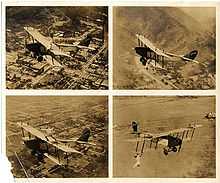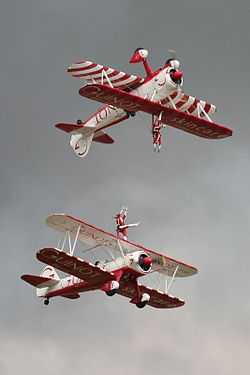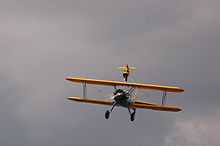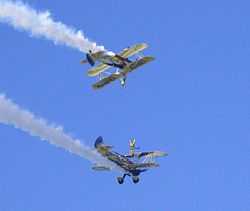Wing walking


Starting in airshows and barnstorming during the 1920s, wing walking is the act of moving on the wings of an airplane during flight.
The beginning of wing walking
The earliest known instance of a wing-walking on a powered aircraft was an experimental flight in England involving a biplane built by Colonel Samuel Franklin Cody in 1911. At Laffan's Plain Cody wished to demonstrate how his Flying Cathedral biplanes had the greatest lateral stability even with a passenger 10 feet 6 inches away from the aircraft's center of gravity.[1][2] The first wing walker to perform daring stunts was 26-year-old Ormer Locklear. Legend has it that he first climbed out onto the lower wings during his pilot training in the Army Air Service during World War I. Undaunted, Ormer just climbed out of the cockpit onto the wings in flight whenever there was a mechanical issue and fixed the problem.[3]
On November 8, 1918, Locklear wowed the crowd at Barron Field, Texas, with his daredevil wing-walking stunts. Wing walking was seen as an extreme form of barnstorming, and wing walkers would constantly take up the challenge of outdoing one another. They themselves admitted (or rather proclaimed proudly) that the point of their trade was to make money on the audience's prospect of possibly watching someone die.[4]
After this first demonstration, wing walkers continued to play an important part in the Army Air Corps (now the U.S. Air Force) and Navy in the advancement of aviation. They were instrumental in the first air-to-air refuelling, as well as long-distance flight records. In 1921, Wesley May strapped a fuel tank on his back and performed a plane-to-plane transfer. Additional tests were undertaken, and a hose with aid of a wing walker was the next exploration into aerial refuelling.[3]
Ormer Locklear led the charge with his plane-to-plane transfer, and many followed. His female equivalent, the first woman to switch planes in the air, was Ethal Dare.
Some of the many aerialists to become popular were Tiny Broderick, Gladys Ingles, Eddie Angel, Virginia Angel, Mayme Carson, Clyde Pangborn, Lillian Boyer, Jack Shack, Al Wilson, Fronty Nichols, Spider Matlock, Gladys Roy, Ivan Unger, Jessie Woods, Bonnie Rowe, Charles Lindbergh, and Mabel Cody (niece of Buffalo Bill Cody).
Eight wing walkers died in a relatively short period during the infancy of wing walking and even the great Ormer Locklear himself perished in 1920 while performing a stunt for a film.[3]
Variations on wing walking became common, with such stunts as doing handstands, hanging by one's teeth, and transferring from one plane to another. A 1931 article on wingwalking on inverted aircraft touted the practical aspect of performing inflight landing-gear inspection or maintenance.[5] Eventually wing walkers began making transfers between a ground vehicle, such as a car, a boat, or a train, to the plane. Other variations included free-falls ending with a last-minute parachute opening.
Charles Lindbergh, whose career in flight began with wing walking, was well known for stunts involving parachutes. Virginia Angel was instrumental in teaching Lindbergh how to wingwalk, which he was did in exchange for flying lessons. "He was a boy that wanted to fly," Virginia remembered, "and he was doing everything he could. Work and money were scarce and any little job that he could do—mechanic, or in any capacity whatsoever that would get him some flying time. The boys would trade work for teaching and he used to do that quite a lot. Jim (Angel) had him walk his wings and naturally I had to teach him. Never complained. It was on the West Coast, mostly in Los Angeles."
The first African-American woman granted an international pilot license, Bessie Coleman, also engaged in stunts using parachutes.[4] Another successful woman in this profession was Lillian Boyer, who performed hundreds of wing-walking exhibitions, automobile-to-plane changes, and parachute jumps.[6]
Then 18-year-old Elrey Borge Jeppesen, better known for developing air navigation manuals and charts, joined Tex Rankin's Flying Circus around 1925; one of his jobs was wing walking.
Flying circuses and wing walkers
Flying circuses formed and they featured a variety of stunt performers. Promoters would herald the way with posters hyping up the danger of air walking and the new celebrities that would perform.
Some famous early flying circuses or troops were The Gates Flying Circus, the Flying Aces Air Circus (Jimmy and Jessie Woods), The 13 Black Cats, The Five Blackbirds (an all African-American team), Mabel Cody's Flying Circus, Bugs McGowen's Flying Circus, and a troop run by Douglas Davis.
The Gates Flying Circus is perhaps the organization that made the most impression on the public. In one day alone, they gave 980 rides. This was done by pilot Bill Brooks at the Steubenville Air show in Ohio. Their one dollar joy ride was a sensation.
When the stock market crash of 1929 occurred, many of the more prominent flying circuses such as The Gates Flying Circus folded. Smaller operations, such as the Flying Aces, with Jimmy and Jessie Woods, continued until the 1938 Air Commerce Act required them to wear a parachute.[3]

After World War II

In the 1970s, stunt men and women still had some restrictions. They had to be attached to the upper wing center section.
In the mid 1970s, Ron David, a pilot and gifted narrator, became the director of the Flying Circus in Bealeton, Virginia. Under his stewardship he returned the air show back to its barnstorming roots and included a wing-walking act. Since the Flying Circus aerodrome was a grass field, he asked the CAA to allow the wing walker out of cockpit during flight and return into the cockpit, so the wing walker could be strapped in for takeoff and landing. His concern was taking off or landing with a wing rider on the top wing and the chance of the plane flipping over if it hit a rut in the grass field. He was granted permission.
His first wing walker was Bill FitzSimons, a jumper with the Flying Circus. Bill left to continue his act around the country with pilot Ron Shelley. Jim Bradley, Bill's understudy, stepped in. Jim was a member of the Saint Michael's Angels there in the Flying Circus Aerodrome in Bealeton, Virginia. Jim tested and developed the fundamentals of their act.
When his Army duty called him, he chose Hank Henry to continue wing walking with Ron. Hank wing walked a year and Ron advertised for a new wing walker. Nour Jorgensen responded to the ad. Jim Bradley, Hank Henry, and Nour Jurgenson busted the boundaries of wing walking. The stunt work they pioneered is still state of the art and continues to inspire wing walkers around the world.[3]
On November 14, 1981, in an event organized by Martin Caidin, 19 skydivers set an unofficial wing-walking world record by standing on the left wing of a Junkers JU-52 aircraft in flight.[7]
On April 21, 2009, Tiger Brewer, an eight-year-old British boy, became the world's youngest wing walker after standing above the wings of his grandfather's plane 304.8 metres (1000 feet) above Gloucestershire, England at speeds of about 161 kilometres per hour (100 mph).[3]
Further information
There are two types of wing-walkers. One is when a person walks along a wingtip to assist a pilot taxiing on the ground in tight quarters to assure adequate clearance. The second type of a wing-walker is when a person walks on the wings of an aircraft while in flight. When a person is strapped to an aircraft wing in flight they are called wing-riders.
In fiction
A wing walker, played by Susan Sarandon, falls to her death in the 1975 film The Great Waldo Pepper.
See also
References
- ↑ Colonel Cody's flight with passenger or assistant on outer panels of aircraft; flyingmachines.ru/ - Russian language website containing some information from Jane's
- ↑ Complete English language version of Russian language aviation site with Jane's information: this page dedicated to Samuel Cody's 1911 aviation experiments
- ↑ 3.0 3.1 3.2 3.3 3.4 3.5 Wingwalking History
- ↑ 4.0 4.1 centennialofflight.net - Wing Walkers
- ↑ Popular Aviation, December 1931, p. 82
- ↑ TheHenryFord.org - Lillian Boyer, "Empress of the Air"
- ↑ Scott, Ed (July 2008), "Getting Up There", Parachutist: 36–39
External links
| Wikimedia Commons has media related to Wing walking. |